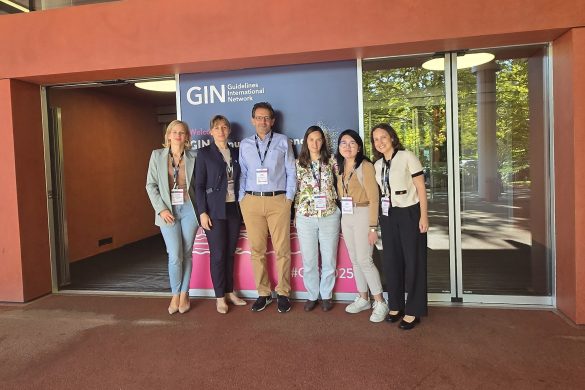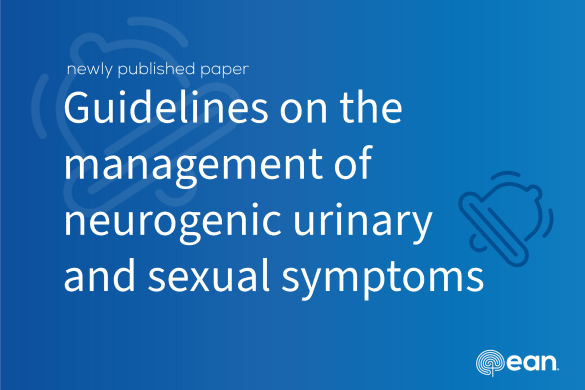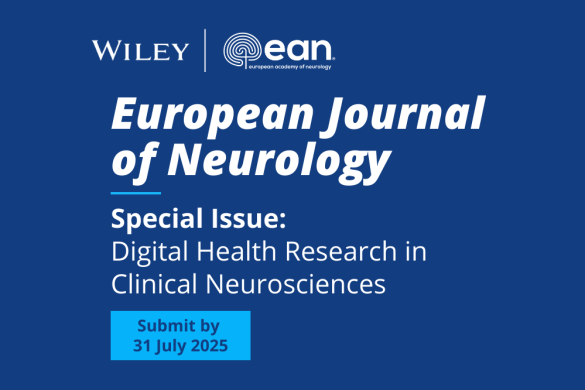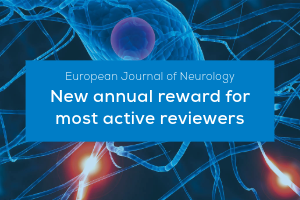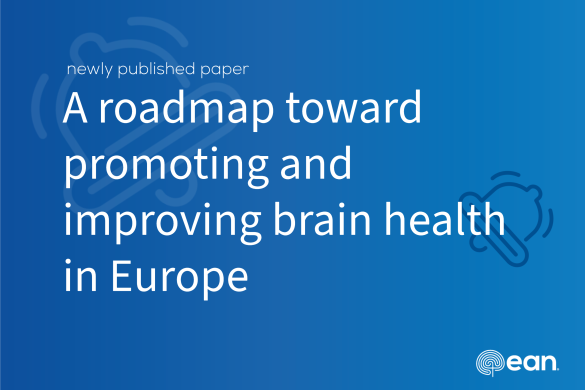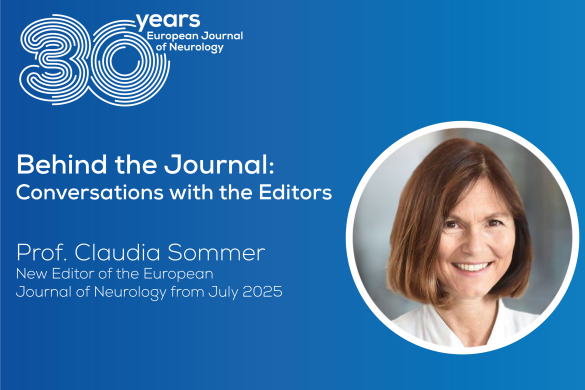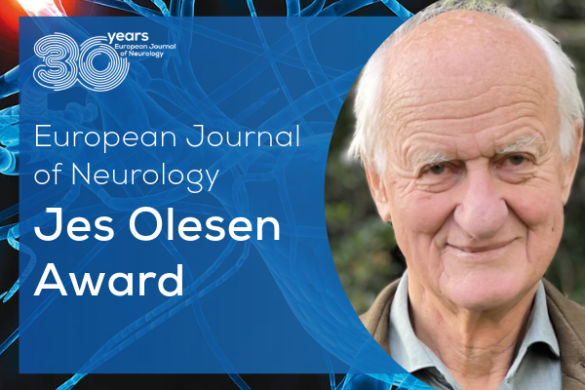 by Anthony Schapira
by Anthony Schapira
The EAN and the European Journal of Neurology together play important, different but complementary and synergistic roles in the pursuit of advancing the clinical neurosciences and their translation to practical patient and carer benefit. The Journal seeks to fulfil several roles in the education and furtherance of neuroscience research. Thus articles are published across a range of topics and incorporate a number of article types including editorials, original research articles, short communications and reviews. Each has its own value within the overall purpose of the journal. We have listed as an example 10 articles of broad interest to the clinical neuroscience community, although the past year has seen many important publications in the Journal.
The basic and clinical neurosciences continue to evolve at an ever increasing pace, delivering new insight into the function of the ‘normal’ brain and nervous system, new tools by which to study physiological and pathological mechanisms, and new treatments for neurological diseases. Neurological disorders are responsible for a huge patient, carer and financial burden, resulting from a combination of their nature and chronicity. The global response to the challenge of neurodegenerative diseases and dementia in particular is testimony to their current and future impact on healthcare services.
The clinical neurosciences have risen to this challenge and major advances have been made in the areas of stroke and multiple sclerosis. The underlying pathophysiology of stroke is an active area of research to identify novel means by which to reduce stroke risk and incidence. The genetic studies now reveal stroke risk genes e.g. GLA, apolipoprotein E and chromosome 12p13 variants. Atrial fibrillation remains a significant target for risk reduction, but detection can be challenging and risk stratification important to address risk/benefit ratio. The management of acute stroke also continues to advance. Thrombolysis is now established as an effective treatment, with the best results in outcome achieved in the first 3 hours of stroke onset. The major challenge remains that of ensuring rapid access to acute stroke units. Access is patchy at best, with most major European cities providing good cover, but inevitably this becomes more challenging outside of these. The current need for brain imaging prior to thrombolysis limits the ability to deliver thrombolysis in the community setting, but novel imaging facilities may overcome this and enable more rapid treatment. Outcomes after stroke are also an important aspect of the value of new treatments. Predicting outcome more accurately enables patient and family to prepare for life post-stroke and healthcare facilities to be put in place for support and rehabilitation. Advances in the management of multiple sclerosis have continued apace and have transformed the neurologists approach to this disorder. Novel risk associations continue to be identified e.g. vitamin D deficiency, symptom phenomenology broadened, particularly in relation to cognitive dysfunction and treatment options evaluated.
Insight into the pathogenesis of the major neurodegenerative diseases has continued to progress and has provided new target pathways for manipulation to slow or prevent their progress/onset. The genetics of Parkinson disease (PD) has enabled a focus on alpha-synuclein and glucocerebrosidase in particular as an important feature potentially contributing to protein aggregation and propagation. The search for biomarkers both biochemical and imaging continues with the prospect of both diagnosis and risk stratification becoming more realistic. The non-motor aspects of PD are of interest not only as important causes of impaired quality of life, but also as potential prodromal markers of motor PD. There have been few new treatments for PD in the recent past, although novel modes of delivery of existing drugs have undoubtedly improved treatment options in advanced disease. Movement disorders in general continue to benefit from the genetics revolution with novel gene associations for essential tremor, dystonia and the ataxias. Identification of gene mutations also widens the clinical phenotype-genotype correlation and emphasizes the potential for exome sequencing for future diagnosis in the neurology clinic. Methcathinone-induced parkinsonism has been an important reminder of the potential for exogenous toxins to target the nervous system. This joins a number of drugs of abuse that have the capacity to simulate certain aspects of neurodegenerative diseases. As treatments for Alzheimer disease enter early phase study, it is emerging that the earlier such treatments are given, the better their prospect of success. Thus the accurate identification of mild cognitive impairment as a prelude to dementia and the potential to detect cerebral amyloid are of great importance. In a similar manner, early diagnosis of amyotrophic lateral sclerosis by genetic or neurophysiological means will offer opportunities for early intervention once such treatments become available.
Headache is probably the commonest neurological problem and is responsible for very significant reduction in quality of life and has major economic consequences. Genetic associations in migraine and in analgesic overuse headache are providing some insight into causation, but genetic factors remain complex, with relatively few single gene causes. The introduction of occipital nerve blocks has offered a new mode of treatment for migraine variants. Epilepsy treatments have transformed the outlook for patients, but there remains a cohort of patients refractory to oral therapies and in whom surgery offers an alternative.
Neuromuscular disorders have led the field in terms of the application of genetics to diagnosis, but lag behind in finding treatments to address these diseases. A notable exception is myasthenia gravis, where a combination of medication and surgery offers cure in a proportion of patients. Inflammatory neuropathies have likewise been amenable to treatment but still recognised to cause significant morbidity. Myotonic dystrophy is a channelopathy with CNS as well as myopathic involvement and in common with other disorders of this class has overlap with neurodegenerative diseases. The inflammatory neuropathies in some cases form an overlap with CNS infections. Distinction is important as treatments are different.
Neurology encompasses an enormous spectrum of disorders, probably the largest of all medical disciplines. Neurological complications of other system diseases are common. The creation of the European Neurological Association bringing together the European Federation of Neurological Societies and the European Neurological Society, is a major step in ensuring the improvement of neurological practice and education across Europe, and will inevitably have an important impact on global neurology.
- Romito et al 22:426 with Cif 22:423
• Romito, L. M., Zorzi, G., Marras, C. E., Franzini, A., Nardocci, N. and Albanese, A. (2015), Pallidal stimulation for acquired dystonia due to cerebral palsy: beyond 5 years. European Journal of Neurology, 22: 426–e32. doi: 10.1111/ene.12596
• Cif, L. (2015), Deep brain stimulation in dystonic cerebral palsy: for whom and for what?. European Journal of Neurology, 22: 423–425. doi: 10.1111/ene.12656 - Reinoso et al 22:457 with Fox & Ceravolo 22:421
• Reinoso, G., Allen, J. C., Au, W.-L., Seah, S.-H., Tay, K.-Y. and Tan, L. C. S. (2015), Clinical evolution of Parkinson’s disease and prognostic factors affecting motor progression: 9-year follow-up study. European Journal of Neurology, 22: 457–463. doi: 10.1111/ene.12476
• Fox, S. H. and Ceravolo, R. (2015), Doctor – how quickly will my Parkinson’s progress?. European Journal of Neurology, 22: 421–422. doi: 10.1111/ene.12502 - Ludolphe & Brettschneider 22:753
• Ludolph, A. C. and Brettschneider, J. (2015), TDP-43 in amyotrophic lateral sclerosis – is it a prion disease?. European Journal of Neurology, 22: 753–761. doi: 10.1111/ene.12706 - Gensicke et al 22:859
• Gensicke, H., Ahlhelm, F., Jung, S., von Hessling, A., Traenka, C., Goeggel Simonetti, B., Peters, N., Bonati, L. H., Fischer, U., Broeg-Morvay, A., Seiffge, D. J., Gralla, J., Stippich, C., Baumgartner, R. W., Lyrer, P. A., Arnold, M. and Engelter, S. T. (2015), New ischaemic brain lesions in cervical artery dissection stratified to antiplatelets or anticoagulants. European Journal of Neurology, 22: 859–e61. doi: 10.1111/ene.12682 - Schmidt et al 22:889
• Schmidt, R., Hofer, E., Bouwman, F. H., Buerger, K., Cordonnier, C., Fladby, T., Galimberti, D., Georges, J., Heneka, M. T., Hort, J., Laczó, J., Molinuevo, J. L., O’Brien, J. T., Religa, D., Scheltens, P., Schott, J. M. and Sorbi, S. (2015), EFNS-ENS/EAN Guideline on concomitant use of cholinesterase inhibitors and memantine in moderate to severe Alzheimer’s disease. European Journal of Neurology, 22: 889–898. doi: 10.1111/ene.12707
Report by Reinhold Schmidt in Neuropenews May 2015 - Abdul-Rahim et al 22:1048 with Kelley 22:1027
• Abdul-Rahim, A. H., Fulton, R. L., Frank, B., Tatlisumak, T., Paciaroni, M., Caso, V., Diener, H.-C., Lees, K. R. and the VISTA collaborators (2015), Association of improved outcome in acute ischaemic stroke patients with atrial fibrillation who receive early antithrombotic therapy: analysis from VISTA. European Journal of Neurology, 22: 1048–1055. doi: 10.1111/ene.12577
• Kelley, R. E. (2015), Combined antithrombotic therapy of potential value in acute atrial fibrillation related stroke. European Journal of Neurology, 22: 1027–1028. doi: 10.1111/ene.12588 - Zis et al 22:1145
• Zis, P., Martinez-Martin, P., Sauerbier, A., Rizos, A., Sharma, J. C., Worth, P. F., Sophia, R., Silverdale, M. and Chaudhuri, K. R. (2015), Non-motor symptoms burden in treated and untreated early Parkinson’s disease patients: argument for non-motor subtypes. European Journal of Neurology, 22: 1145–1150. doi: 10.1111/ene.12733 - Dersch et al 22:1249
• Dersch, R., Freitag, M. H., Schmidt, S., Sommer, H., Rauer, S. and Meerpohl, J. J. (2015), Efficacy and safety of pharmacological treatments for acute Lyme neuroborreliosis – a systematic review. European Journal of Neurology, 22: 1249–1259. doi: 10.1111/ene.12744 - Konczalla et al 22:1329
• Konczalla, J., Schmitz, J., Kashefiolasl, S., Senft, C., Seifert, V. and Platz, J. (2015), Non-aneurysmal subarachnoid hemorrhage in 173 patients: a prospective study of long-term outcome. European Journal of Neurology, 22: 1329–1336. doi: 10.1111/ene.12762 - Leone et al 22:1495
• Leone, M. A., Keindl, M., Schapira, A. H., Deuschl, G. and Federico, A. (2015), Practical recommendations for the process of proposing, planning and writing a neurological management guideline by EAN task forces. European Journal of Neurology, 22: 1505–1510. doi: 10.1111/ene.12818
Anthony Schapira is Professor of Neurology at the Departmentof Clinical Neurosciences at the University College London, UK, and he is the Edito-in-chief of the European Journal of Neurology





